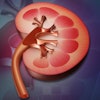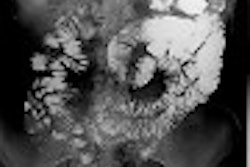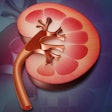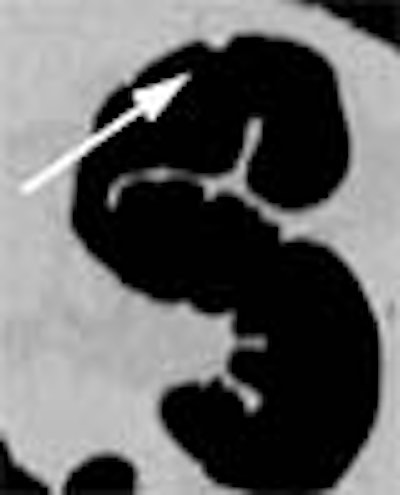
In Europe, where reduced radiation is next to godliness, researchers have produced excellent virtual colonoscopy results using sharply lower exposures. The ultralow-dose technique may limit radiologists' ability to find extracolonic abnormalities, but its sensitivity and specificity were every bit as high as those in studies using twice the dose.
At the 2003 European Congress of Radiology in Vienna, Dr. Riccardo Iannaccone from the University of Rome, La Sapienza, discussed his group's research aimed at assessing the performance of ultralow-dose virtual colonoscopy compared with conventional colonoscopy.
"We know that dose reduction is feasible because of the high contrast (at) the colonic air-wall interface," he said.
In the study, Iannaccone, Dr. Andrea Laghi, Dr. Roberto Passariello and colleagues examined 158 consecutive patients using same-day virtual and conventional colonoscopy. Following standard bowel preparation, all patients (88 male and 70 female, 31 screening and 127 symptomatic subjects) underwent ultralow-dose multislice CT virtual colonoscopy.
"We performed a prospective blinded comparison with conventional colonoscopy performed right after CT colonography," Iannaccone said. "All patients underwent standard bowel preparation, an antispasmodic drug (Buscopan, 20 mg) was intravenously administered, and air insufflation was achieved to maximum patient tolerance," Iannaccone said.
Images were acquired on a Somatom Plus 4 Volume Zoom scanner (Siemens Medical Solutions, Erlangen, Germany) using 4 x 2.5-mm beam collimation, table feed of 17.5 mm/sec, 140 kVp, and effective mAs set way down to 10, in both supine and prone positions. Sensitivity was calculated both per polyp and per patient, and the radiation dose was calculated using commercially available software.
Two radiologists experienced in virtual colonoscopy read the images directly on the workstation "using a time-efficient approach, starting with 2-D, and when a suspected lesion was found, using 3-D (multiplanar reconstructions) for confirmation," Iannaccone said. The radiologists noted the size and location of all detected polyps. A single experienced gastroenterologist performed the conventional colonoscopy procedures.
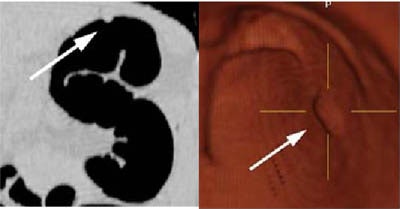 |
| Above, two views of a 6-mm (diameter) polyp within the splenic flexure: coronal MPR (left), and 3-D (right). Images courtesy of Dr. Riccardo Iannaccone. |
According to the per-polyp results, conventional colonoscopy found 22 carcinomas, and low-dose VC detected 100% of them. Virtual colonoscopy detected 52 of 74 polyps, for an overall sensitivity of 70.3%. Virtual colonoscopy's sensitivity for the detection of polyps 10 mm and larger was 100% (13/13), 83.3% (20/24) for the detection of polyps 6-9 mm in diameter, and 51.3% (19/37) for polyps 5 mm and smaller.
"I would like to emphasize that we had 89.1% sensitivity for polyps 6 mm in diameter or larger," Iannaccone said.
In the per-patient analysis, virtual colonoscopy had a sensitivity of 96%, specificity of 96.6%, a positive predictive value of 94.1%, and a negative predictive value of 97.7%.
Moreover, the radiation dose was far lower than typically seen in standard-dose virtual colonoscopy, Iannaccone said. The total weighted CT dose for combined prone and supine acquisitions was 2.74 mGy. The effective doses were 1.8 mSv for men and 2.4 mSv for women, far lower than previously published results using standard doses.
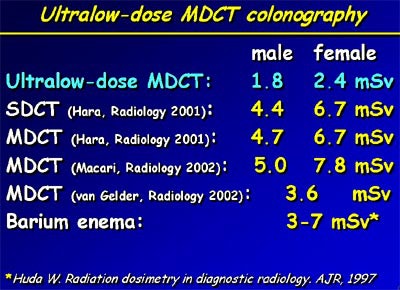 |
| Comparative radiation doses in colon exams. Chart courtesy of Dr. Riccardo Iannaccone. |
"To conclude, CT colonography can tolerate substantial radiation dose reduction while maintaining excellent sensitivity for colorectal carcinomas and polyps larger than 6 mm in diameter," Iannaccone said. "Therefore, this technique is a viable alternative to standard-dose (virtual colonoscopy) when questions of radiation exposure are a major concern."
However, he added, the technique's diagnostic powers may be reduced with respect to incidental findings in structures such as the liver, the pancreas, and the lymph nodes, where low intrinsic contrast makes image noise a bigger problem.
That's why the group is working on applying noise-reduction filters in the next set of patients, Iannaccone said.
By Eric BarnesAuntMinnie.com staff writer
April 8, 2003
Related Reading
Meta-analysis of virtual colonoscopy studies yields promising results, March 19, 2003
Waist size predicts optimal CT dose in virtual colonoscopy, February 7, 2003
Low-dose CT colonography accurately detects large colorectal neoplasms, July 30, 2002
Ultra-low-dose CT colonography compares with colonoscopy, March 3, 2002
Copyright © 2003 AuntMinnie.com

